Every customer interaction with your business defines how buyers perceive your brand, shaping their loyalty and directly impacting sales.
The challenge is knowing where all customer touchpoints occur and how to optimize them for better results.
This article shows you how to identify, analyze and improve touchpoints across the customer journey. Learn practical strategies and examples to streamline processes, personalize communication and turn interactions into growth.
Key takeaways from customer touchpoints
Customer touchpoints are individual moments when customers interact with your brand across the buying journey.
Understanding and improving these touchpoints helps SMBs build trust, boost satisfaction and increase conversions.
For SMBs who struggle to manage touchpoints consistently, using a CRM can streamline communication and follow-ups.
Pipedrive’s CRM makes it easy to track, automate and personalize every touchpoint so you can drive long-term growth – sign up for a free 14-day trial.
What are customer touchpoints?
Customer touchpoints are the points of contact between a consumer and your business.
These touchpoints happen online or offline. For example, interacting with staff in-store or discovering your business online and becoming a loyal customer.
What are touchpoints for? Put simply, each touchpoint shapes how your target customer base perceives your business and influences their purchasing decisions.
Small and medium-sized businesses (SMBs) need reliable touchpoints to understand customer needs, tailor their products to the right market and boost sales effectively.
What are common SMB client touchpoints (with examples)
Customer touchpoints fall into three main stages: pre-purchase, purchase and post-purchase:
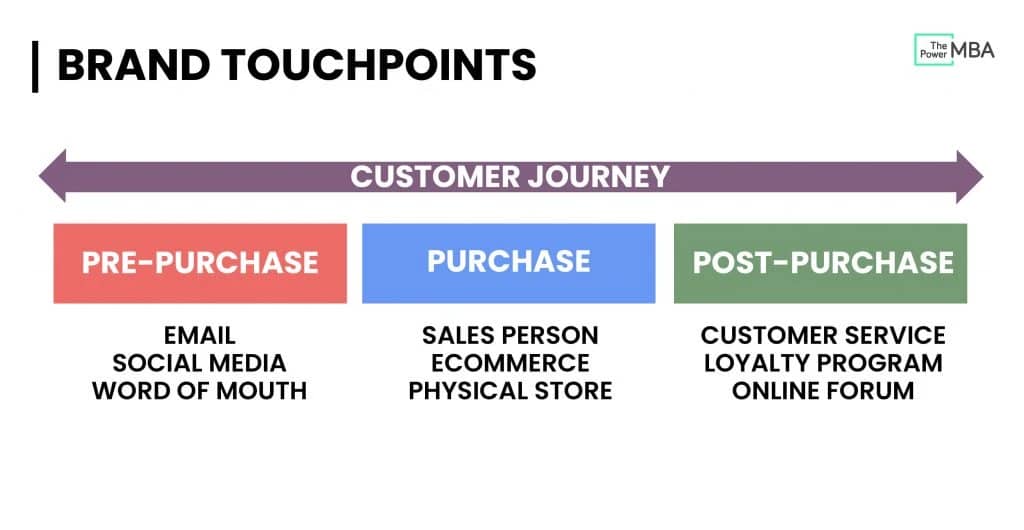
Source: The Power MBA
Touchpoint mapping shows the full customer journey. The process identifies where you can improve engagement, reduce friction and deliver a better experience.
The following sections explain each stage more closely, with examples of customer touchpoints showing how they work.
Pre-purchase consumer touchpoints
Pre-purchase touchpoints occur before the customer buys from you.
Consistent, trustworthy and engaging pre-purchase experiences build the momentum that drives conversions.
For example, a prospective customer could:
Visit your website after finding you on Google
Read online reviews about your business on platforms like Trustpilot or Yelp
See a post or ad from your social media platform
Here’s an example of a paid social media ad from website builder SaaS Framer on LinkedIn:

Source: LinkedIn
By appearing in users’ feeds, this ad raises brand awareness and introduces Framer’s value proposition. It also highlights a solution to a common pain point: building and launching a website.
Here’s how the ad nurtures leads at the start of their journey:
Educating users about the benefits of using Framer
Encouraging clicks to learn more or try the platform
Establishing trust and familiarity with the brand before any transaction
In short, this touchpoint captures interest. It informs potential customers and sets the stage for future interactions that can lead to conversions.
Purchase touchpoints
Purchase touchpoints occur at the point of sale.
They directly affect how smooth and satisfying the customer’s experience is when making a purchase.
Common examples include customers:
Interacting with your staff in person
Browsing your pricing options and online shop before adding items to the cart
Receiving a confirmation email, invoice or receipt after payment
Take a look at this confirmation email from vegan skincare brand Haoma:

Source: Really Good Emails
This email engages the customer immediately after buying, reinforcing their decision and creating a positive emotional connection with the brand.
Highlighting the tree-planting initiative also enhances Haoma’s brand perception. Customers learn that their purchase has a meaningful impact beyond the product itself.
Post-purchase consumer touchpoints
Post-purchase touchpoints happen after the customer completes their purchase.
They’re key for building customer loyalty, ensuring repeat business and sales referrals.
Typical examples include existing customers:
Going through customer onboarding after receiving their product or service
Calling your customer service teams for support
Leaving feedback or writing a customer review about their experience
Receiving a follow-up email with helpful product tips or upselling opportunities
Here’s another example from Framer:

Source: Really Good Emails
This post-purchase email suggests additional templates and features customers might like, keeping the brand top of mind after their initial purchase.
It also strengthens relationships and boosts loyalty and customer lifetime value (CLV) without a significant marketing spend.
Why customer touchpoints matter for SMBs
Monitoring and optimizing your SMB’s customer touchpoint strategy helps you deliver a seamless buyer journey, build better relationships and get more value from your limited resources.
The key benefits include:
Enhancing customer success | Smooth, consistent touchpoints grow trust and reduce friction. As a result, it’s easier for consumers to move through the customer journey and make a purchase. |
Shaping first impressions | A quick reply or smooth checkout sets the tone for the entire customer relationship. Positive early interactions create confidence in your business and help you stand out from competitors. |
Monitoring customer interactions identifies where people drop off, such as abandoned carts, unanswered inquiries or confusing website pages. Fixing these points improves the journey and prevents lost sales. | |
Stretching resources | SMBs often operate with limited sales budgets and staff. Focusing on the most impactful touchpoints ensures efficient use of time and money, maximizing return on investment. |
Driving referrals | Positive experiences, like quick issue resolution or attentive service, encourage customers to leave reviews and recommend your business to others, expanding reach at minimal cost. |
Boosting loyalty | Thoughtful customer support, timely follow-ups and helpful communication show that you care. These consistent experiences turn one-time buyers into long-term, repeat customers. |
By paying attention to each touchpoint, SMBs can create a customer journey that satisfies buyers and drives growth for long-term success.
5 simple but effective ways to identify customer touchpoints
Listing all possible customer interactions, gathering feedback and creating a customer journey map are some ways to identify touchpoints.
These five steps help your SMB pinpoint key interactions and optimize the customer journey.
1. Create a customer journey map
Identify customer touchpoints by tracking the key interactions across the entire customer journey.
Start by outlining the stages your customers move through so you can see where touchpoints naturally occur. To do this, create a clear framework of the buying journey for your ideal customer persona.
Here’s how the map might look:
Pre-purchase (also known as awareness and consideration). New customers discover your business through ads, social media posts, search engines or word-of-mouth. They research your products, read reviews and compare options.
Purchase. They make a transaction on your website, interact with sales teams or receive confirmation emails.
Post-purchase. They seek support, leave reviews or receive follow-up emails with tips or offers.
Mapping these stages helps you understand where customers interact with your brand and the opportunities to improve their experience.
Download our Customer Journey Map Template
CRM systems like Pipedrive let you track and visualize the entire journey, making it easy to see where touchpoints exist and where additional customer engagement could help.
For example, create pipeline stages to align the process with your unique customer journey. Then, monitor leads and deals as you nurture them.
Here’s how these stages look in Pipedrive:

With this oversight, you can nurture leads effectively, sharing information at the right time to increase the likelihood of conversion.
Pipedrive in action: Network Financial Planning uses Pipedrive to streamline client acquisition and management. Integrating lead creation, sales tracking and project management gives the business a full view of the customer journey.
Since adopting Pipedrive, the solo operation has expanded to a team of six, with 85% of its processes now running through the platform. The company also completes over 50% more activities.
2. List all possible interactions
Identifying every way a customer interacts with your business ensures you take every opportunity to influence and improve their experience.
Start by thinking broadly about how people might come into contact with your brand. For example, a customer might:
Visit your website landing pages to read blog content or visit your knowledge base
Click on social media ads or organic posts
Respond to email marketing campaigns or newsletters
Call your customer service line with questions
Visit your physical store or pop-up location
Attend events, webinars or workshops
Read or leave reviews on platforms like Google or Yelp
To capture all of these interactions systematically, follow these key steps:
Audit your channels | Action: List all online and offline platforms where customers can see or engage with your brand. Purpose: Capture every touchpoint and provide a complete view of where potential customers first encounter your business. |
Track communication touchpoints | Action: Include emails, chatbot messages, phone calls and direct messages. Purpose: Understand how customers ask questions, raise complaints or concerns and respond to your outreach, highlighting key engagement points. |
Review marketing campaigns | Action: Identify every ad, social post or content piece that sparks engagement. Purpose: Reveal which marketing efforts attract attention and create meaningful opportunities to connect with customers. |
By listing all interactions, you create a comprehensive map of potential touchpoints to optimize engagement at every stage.
3. Gather customer feedback
Asking customers for feedback gives you direct insight into which touchpoints matter most and where you can improve the overall experience.
Example: A SaaS company sends a short net promoter score (NPS) survey after onboarding a new customer. It asks for feedback about ease of use, clarity of instructions and overall satisfaction.
Customer responses reveal that certain features are confusing or that in-app guidance is insufficient, highlighting touchpoints that need improvement.
This direct feedback allows the company to refine the product experience, increase user satisfaction and boost customer retention.
Apply these strategies to collect meaningful feedback from customers at every point:
Send online feedback surveys and forms | Action: Ask users targeted questions after key interactions like onboarding, feature use or support calls. Purpose: Pinpoint which touchpoints work well and where users encounter difficulties. |
Encourage reviews | Action: Request reviews on your website or review platforms. Purpose: Reveal what users value most and expose friction points that may not appear in internal data. |
Include feedback prompts in emails | Action: Add short, easy-to-complete questions in follow-up emails after product use. |
Monitor social channels | Action: Track comments, messages and user discussions online. Purpose: Collect more honest feedback than customer surveys or forms, revealing insights that users might not be comfortable sharing in direct responses. |
Centralizing and analyzing this data is another key part of the process.
A CRM like Pipedrive allows you to see patterns, identify key touchpoints and understand customer behavior throughout the journey.
Use Pipedrive’s sales dashboards to view key customer data at a glance and quickly spot trends in engagement, drop-offs and conversions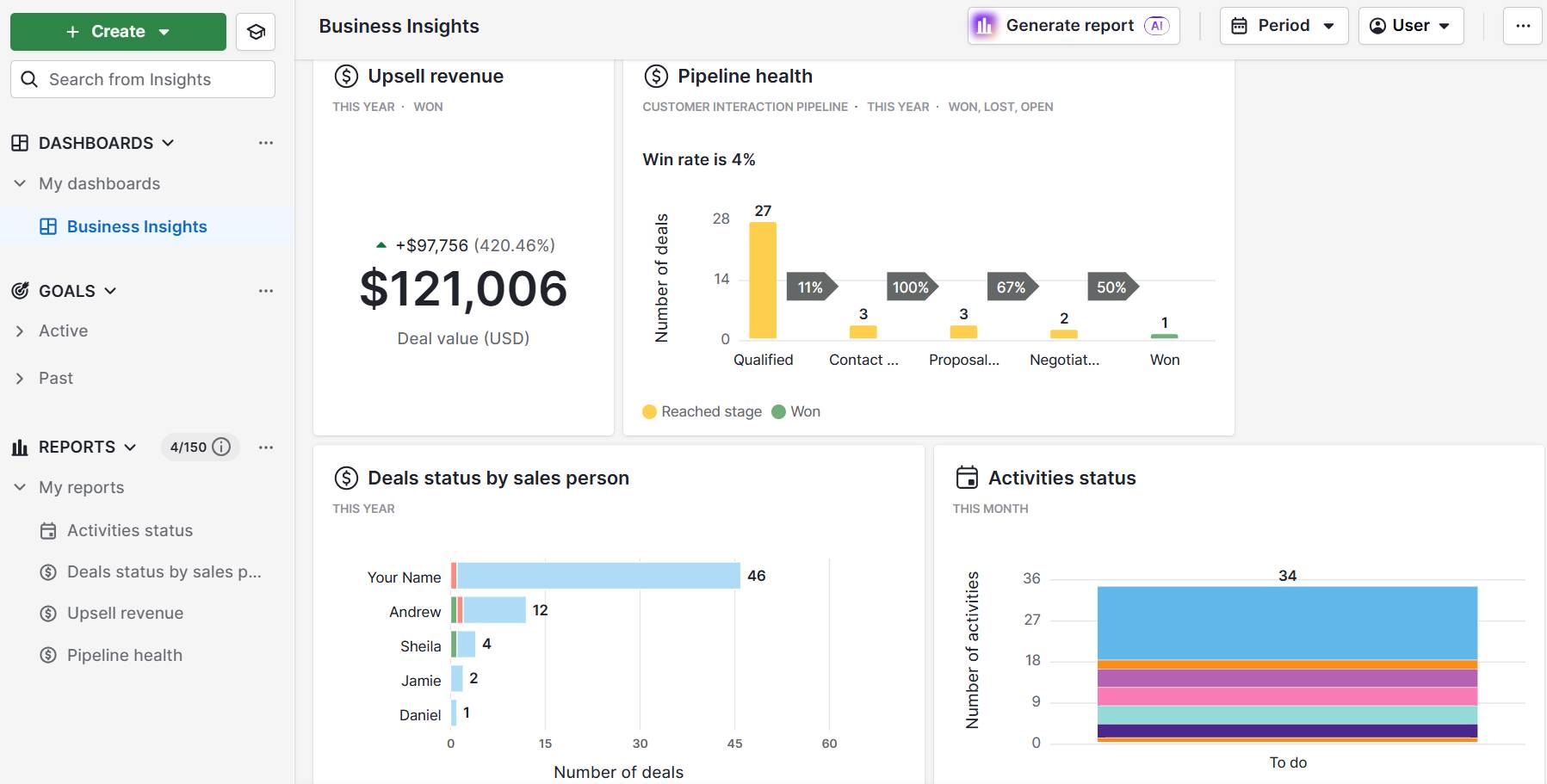
This visibility helps SMBs identify which touchpoints are working well and which need improvement.
By analyzing these patterns, you make data-driven business decisions to optimize interactions and enhance the overall sales cycle.
4. Check your analytics
Monitoring analytics lets you see exactly how customers interact with your brand and identify which touchpoints are effective.
Example: On reviewing its analytics, a financial services firm notices that many potential clients visit the “Investment Plans” page but abandon the process before scheduling a consultation.
This data highlights a key touchpoint where prospects hesitate. The business now has an opportunity to improve the user experience by clarifying plan benefits or simplifying the booking process.
Consider the following strategies to analyze your client touchpoints:
Action: Monitor page views, clicks, bounce rates and navigation paths using tools like Google Analytics. Purpose: Identify which web pages attract attention, which lose visitors and which touchpoints need optimization. | |
Monitor social media interactions | Action: Review likes, shares, comments and clicks across social platforms. Purpose: Understand which posts or campaigns generate engagement and which touchpoints fail to resonate. |
Analyze email marketing performance | Action: Measure email opens, click-through rates and conversions from newsletters, drip campaigns or promotions. Purpose: Reveal how effectively your communications drive action and where customers disengage. |
Track conversion paths | Action: Map how leads move from first contact to purchase using CRM data. Purpose: Pinpoint areas of friction and make necessary improvements. |
Centralizing and analyzing customer data is essential for understanding effective touchpoints. A single source of truth helps you see patterns and identify where leads drop off across the buying journey.
Pipedrive’s sales CRM consolidates all interactions (like website visits, emails, calls, social engagement and support requests) into one platform.
This data allows businesses to visualize customer behavior, identifying which touchpoints drive conversions and lose business leads.
Pipedrive’s custom reports and insights feature also make it easy to track key metrics at a glance, monitor trends over time and measure the effectiveness of specific touchpoints.
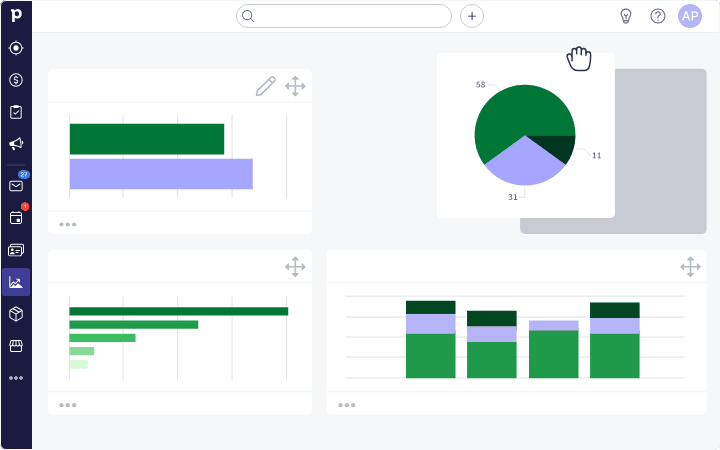
By analyzing the data, your SMB can make informed decisions to improve customer interactions and increase sales.
5. Involve your frontline staff
Frontline employees see firsthand how customers interact with your business, making them a valuable source of insight into which touchpoints work well and which need improvement.
Example: A consulting firm asks client-facing consultants to report which questions or concerns come up most often during client meetings.
These insights reveal recurring friction points, such as unclear onboarding instructions, confusing proposals or gaps in service explanations. Identifying these issues allows the firm to optimize these touchpoints and improve the overall client experience.
Follow the steps below to involve your staff in identifying and refining customer touchpoints:
Conduct sales team interviews | Action: Meet with sales, support or service employees to ask about common customer questions and complaints. Purpose: Gain direct insight into which touchpoints influence customer satisfaction and conversion. |
Create staff feedback forms | Action: Ask employees to log frequent issues or observations from their daily customer interactions. Purpose: Identify key patterns across touchpoints. |
Host workshops or brainstorming sessions | Action: Bring teams together to map the customer journey from their perspective. Purpose: Uncover touchpoints by collaborative team sessions that analytics or surveys might not reveal. |
Track anecdotal observations | Action: Encourage staff to note unusual interactions, exceptional experiences or moments where customers hesitate. Purpose: Highlight opportunities to improve engagement. |
Involving frontline staff gives SMBs a clear view of customer pain points and opportunities for improvement.
How SMBs can optimize customer touchpoints
Optimizing consumer touchpoints gives SMBs a practical way to improve the buying journey, increase sales and drive growth.
Here are some practical strategies for strengthening key touchpoints.
Map the customer journey with simple tools and methods
Mapping the customer journey helps SMBs see the big picture, making it easier to understand how customers move through the sales process and how to refine each stage for better results.
There’s a lot of complex software on the market for plotting and tracking customer journeys. However, smaller businesses with limited budgets don’t need to invest in expensive tools.
Here are some simple, cost-effective tools and methods for mapping purposes:
Use free online templates. Journey mapping templates from platforms like Pipedrive or Canva provide a structured starting point and save time while ensuring you capture key touchpoints.
Create basic CRM pipelines. A simple and customizable CRM like Pipedrive lets you create deal stages that mirror the customer journey. Tracking leads as they move through stages highlights where customers stall and helps you prioritize improvements.
These tactics give SMBs a clear, actionable view of the customer journey to make improvements without a significant investment.
Focus on high-impact client touchpoints
Not all interactions carry the same weight, so SMBs can maximize resources by prioritizing touchpoints that require small changes for the biggest wins.
Example: A small consulting firm notices leads dropping off when booking a discovery call. By simplifying the booking process (removing unnecessary form fields and adding an automated confirmation email), the company can quickly improve the user experience.
These small changes lead to more consultations without draining time and resources.
Here’s how to identify high-impact touchpoints for your business:
Analyze conversion data. Review CRM metrics or analytics tools to identify touchpoints where leads stall but require minimal effort to fix. Focusing on these quick wins helps you boost conversions with low-effort improvements.
Collect customer feedback. Ask clients which interactions were confusing, slow or frustrating. Feedback highlights the touchpoints that affect satisfaction so you can prioritize improvements with the biggest impact.
Review support team insights. Consult frontline employees about common customer questions or complaints. Their observations reveal critical touchpoints that may not appear in data alone, helping you focus on critical changes that improve the overall journey.
Prioritizing these high-impact touchpoints ensures your SMB uses its time and resources efficiently. Your businesses will be able to deliver a smoother customer experience that drives conversions and builds brand loyalty.
Improve communication speed and clarity
Fast and clear communication reduces confusion, strengthens trust and ensures customers move smoothly through the buying journey.
Example: A small SaaS company notices that prospects often request a sales demo but don’t book a session unless they get a timely response. By responding quickly to their request, the company increases the likelihood of conversion.
Follow these tips to make your communication with customers more effective:
Automate routine messages. Use CRM tools like Pipedrive to send instant email confirmations, follow-ups and reminders. Email automation ensures customers receive timely updates without adding extra work for staff.
Standardize messaging. Create clear, concise templates for emails, chat responses or in-app notifications. Consistent messaging helps customers understand processes and expectations, minimizing confusion across touchpoints.
Monitor response times. Track how quickly staff respond to inquiries using CRM dashboards or analytics. Identifying slow points allows SMBs to adjust workflows or resources so that customers always receive prompt, reliable communication.
Clear and consistent communication helps SMBs build trust, engage leads and convert more prospects into loyal customers.
Personalize follow-ups
Personalizing follow-ups strengthens relationships, improves nurturing and increases the likelihood of renewals or long-term partnerships.
Example: A small manufacturer delivers a conveyor system to a food packaging company. After installation, the manufacturer emails a personalized maintenance schedule, troubleshooting video and recommended attachments.
This tailored follow-up helps the client maintain their equipment efficiently. It minimizes downtime and shows that the manufacturer understands their specific customer needs.
Here are some tips to make follow-ups more effective:
Send tailored thank-you messages. Include the customer’s name and reference their recent order or interaction. Personalized customer appreciation makes them feel valued, loyal and likely to buy again.
Offer relevant recommendations. Suggest compatible products, upgrades or services based on the customer’s purchase history. Targeted recommendations help clients get more value and drive additional sales.
Schedule timely reminders. Send follow-ups at the right moment, such as before scheduled maintenance or product upgrades. Timing messages to align with client needs ensures relevance and encourages action.
A CRM helps SMBs manage personalized follow-ups by planning, scheduling and automating communications.
Pipedrive, for instance, allows businesses to schedule follow-up emails and set automated reminders for sales reps to contact leads.
Here’s an example of an email automation sequence in Pipedrive:
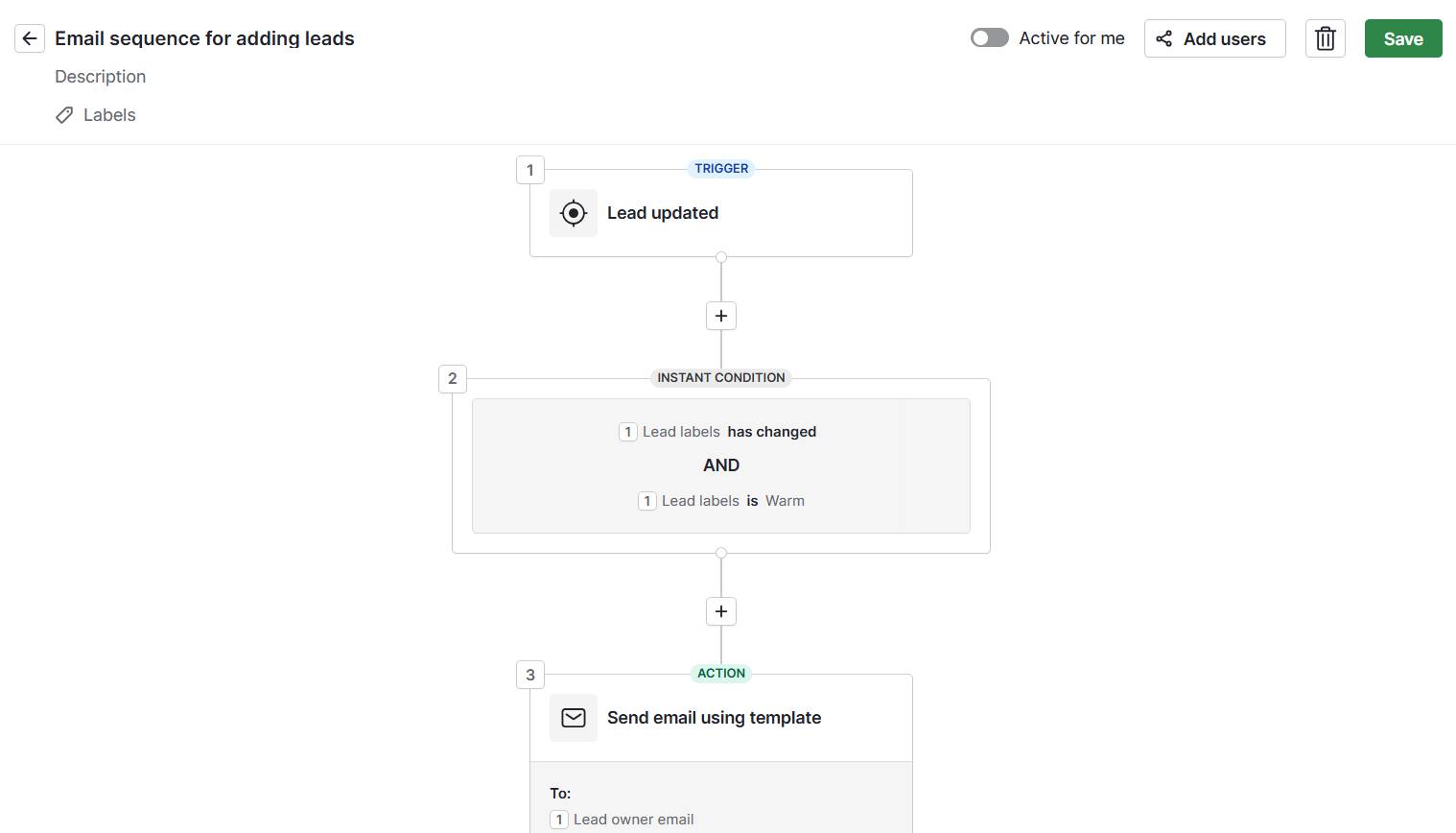
Writing compelling emails can be a time-consuming, laborious process that strains sales and customer support reps. When content quality starts to drop, conversions will too.
The Pipedrive AI email generator eases creative stress by turning natural language instructions on tone, style and length into high-quality email drafts.
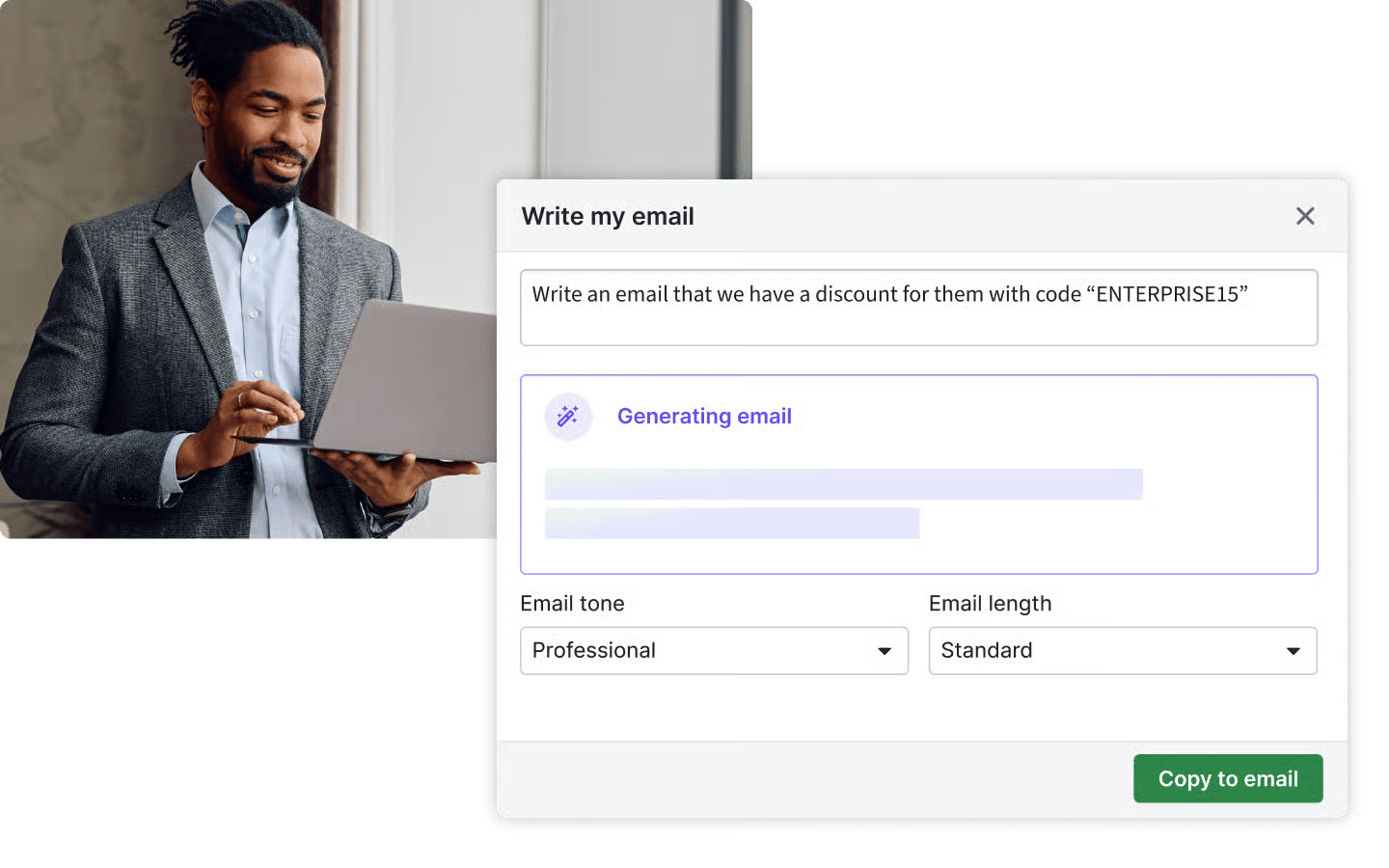
This functionality ensures every follow-up is timely and relevant, turning each interaction into an opportunity to deepen engagement and drive conversions.
Customer touchpoints FAQs
Final thoughts
Every customer touchpoint directly shapes satisfaction, loyalty and growth. To optimize every stage of the buying journey, SMBs must map all touchpoints, prioritize high-impact moments and personalize communication.
Use a tool like Pipedrive’s CRM to centralize interactions, automate reminders, schedule personalized follow-ups and track engagement performance.
Sign up for a free 14-day trial to transform every customer interaction into stronger relationships and higher conversions.







